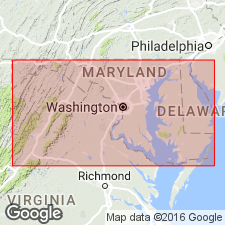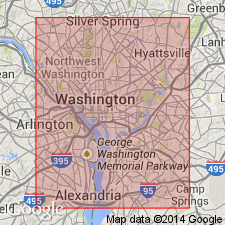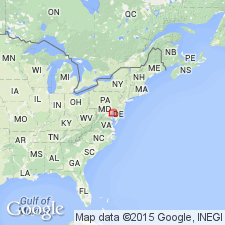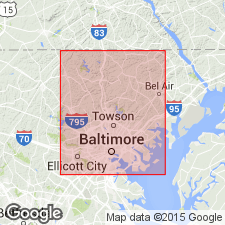
- Usage in publication:
-
- Arundel formation*
- Modifications:
-
- Original reference
- Dominant lithology:
-
- Clay
- AAPG geologic province:
-
- Atlantic Coast basin
Summary:
Pg. 156, 190. Arundel formation of Potomac group. Series of large and small lenses of iron-ore bearing clays that occupy ancient depressions in surface of Patuxent formation. The largest lenses nearly 125 feet thick. The clays are highly carbonaceous. Lignitized trunks of trees are often found in upright position with their roots still intact. Vast quantities of nodules of iron carbonate are scattered through the tough dark clays. In upper part of formation the carbonate ores have changed to hydrous oxides of iron. Fossils are mainly dinosaurian remains. Unconformably underlies Patapsco formation. Included in Potomac group. Age is Early Cretaceous.
Named from Anne Arundel Co., eastern MD.
Source: US geologic names lexicon (USGS Bull. 896, p. 78).

- Usage in publication:
-
- Arundel clay*
- Modifications:
-
- Areal extent
- AAPG geologic province:
-
- Atlantic Coast basin
Summary:
Geographically extended the Arundel clay of the Potomac group to Washington, DC. Description of lithology is quoted from Clark (1897). Unit unconformably overlies the Patuxent formation of the Potomac group and unconformably underlies the Patapsco formation of the Potomac group. The Arundel is of Late Cretaceous age.
Source: GNU records (USGS DDS-6; Reston GNULEX).

- Usage in publication:
-
- Arundel Clay
- Modifications:
-
- Biostratigraphic dating
- AAPG geologic province:
-
- Atlantic Coast basin
Summary:
The Arundel Clay of the Potomac Group consists primarily of dark gray, red, and brown clay with lignite, leaf compressions, siderite, and hydrous iron oxide nodules. Clay is quite plastic and tough. Thickness ranges from a few feet to 125 feet. Unit unconformably overlies the Patuxent Formation of the Potomac Group and unconformably underlies the Patapsco Formation of the Potomac Group. Spore and pollen data suggests that the Arundel is of Early Cretaceous (Barremian) age, but may range into the Late Cretaceous (Albian).
Source: GNU records (USGS DDS-6; Reston GNULEX).

- Usage in publication:
-
- Arundel Formation
- Modifications:
-
- Overview
- AAPG geologic province:
-
- Atlantic Coast basin
Summary:
Arundel Formation of Potomac Group mapped in Baltimore Co., MD, where it is divided into clay and sand facies. Clay facies is 0.5 to 10 m thick and is gray, brown, black and red kaolinitic and illitic clays with quartz silt locally interbedded with quartz sand lenses and pods. Sand facies is 0.5 to 3 m thick and is well-sorted, medium- to fine-grained quartz sand with locally abundant lignite fragments. Age is Early Cretaceous.
Source: GNU records (USGS DDS-6; Reston GNULEX).
For more information, please contact Nancy Stamm, Geologic Names Committee Secretary.
Asterisk (*) indicates published by U.S. Geological Survey authors.
"No current usage" (†) implies that a name has been abandoned or has fallen into disuse. Former usage and, if known, replacement name given in parentheses ( ).
Slash (/) indicates name conflicts with nomenclatural guidelines (CSN, 1933; ACSN, 1961, 1970; NACSN, 1983, 2005, 2021). May be explained within brackets ([ ]).

